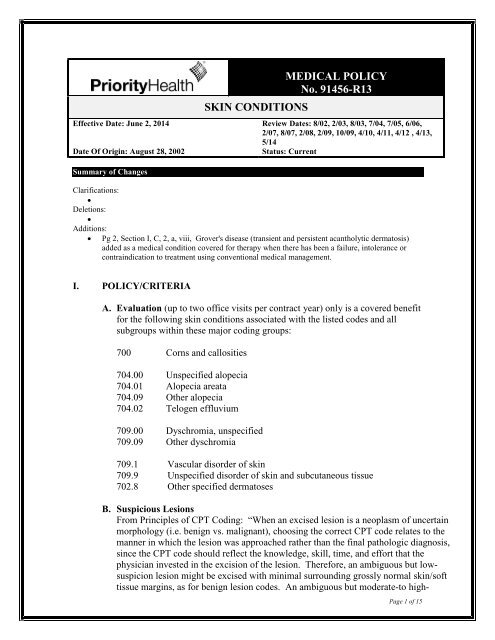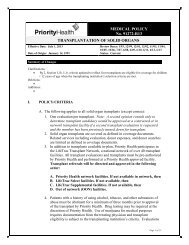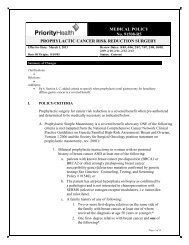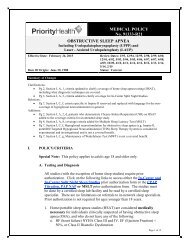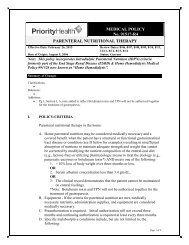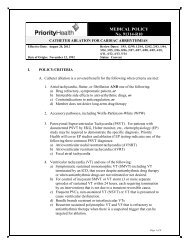Skin Conditions - Priority Health
Skin Conditions - Priority Health
Skin Conditions - Priority Health
Create successful ePaper yourself
Turn your PDF publications into a flip-book with our unique Google optimized e-Paper software.
SKIN CONDITIONSMEDICAL POLICYNo. 91456-R13Effective Date: June 2, 2014 Review Dates: 8/02, 2/03, 8/03, 7/04, 7/05, 6/06,2/07, 8/07, 2/08, 2/09, 10/09, 4/10, 4/11, 4/12 , 4/13,5/14Date Of Origin: August 28, 2002Status: CurrentSummary of ChangesClarifications:•Deletions:•Additions:• Pg 2, Section I, C, 2, a, viii, Grover's disease (transient and persistent acantholytic dermatosis)added as a medical condition covered for therapy when there has been a failure, intolerance orcontraindication to treatment using conventional medical management.I. POLICY/CRITERIAA. Evaluation (up to two office visits per contract year) only is a covered benefitfor the following skin conditions associated with the listed codes and allsubgroups within these major coding groups:700 Corns and callosities704.00 Unspecified alopecia704.01 Alopecia areata704.09 Other alopecia704.02 Telogen effluvium709.00 Dyschromia, unspecified709.09 Other dyschromia709.1 Vascular disorder of skin709.9 Unspecified disorder of skin and subcutaneous tissue702.8 Other specified dermatosesB. Suspicious LesionsFrom Principles of CPT Coding: “When an excised lesion is a neoplasm of uncertainmorphology (i.e. benign vs. malignant), choosing the correct CPT code relates to themanner in which the lesion was approached rather than the final pathologic diagnosis,since the CPT code should reflect the knowledge, skill, time, and effort that thephysician invested in the excision of the lesion. Therefore, an ambiguous but lowsuspicionlesion might be excised with minimal surrounding grossly normal skin/softtissue margins, as for benign lesion codes. An ambiguous but moderate-to high-Page 1 of 15
MEDICAL POLICYNo. 91456-R13<strong>Skin</strong> <strong>Conditions</strong>suspicion lesion would be excised with moderate to wide surrounding grossly normalskin/soft tissue margins as for malignant lesions codes.”C. Treatment of <strong>Skin</strong> <strong>Conditions</strong>1. Treatment of cosmetic skin conditions (including but not limited to thoselisted above) is not a covered benefit. <strong>Priority</strong> <strong>Health</strong> defines cosmetic as anycondition which if left untreated will result in no adverse medical outcome.2. PUVA and UVB Therapy:a. Phototherapy and photochemotherapy is medically necessary whenthere has been a failure, intolerance or contraindication to treatmentusing conventional medical management for ANY of the followingmedical conditions:i. atopic dermatitis (atopic eczema)ii. connective tissue diseases involving the skin (e.g.,cutaneous graft vs. host disease [GVHD], localizedscleroderma, lupus erythematosus)iii. cutaneous T-cell lymphoma (CTCL), includingmycosis fungoides (MF)iv. lichen planusv. photodermatoses (e.g., polymorphic light eruption,actinic prurigo, chronic actinic dermatitis)vi. chronic plaque psoriasisvii. pityriasis (696.4)viii. Grover's disease (transient and persistent acantholyticdermatosis)Phototherapy includes type A ultraviolet (UVA) radiation; typeB ultraviolet (UVB) phototherapy; and combinationUVA/UVB phototherapy. Photochemotherapy includespsoralens (P) and type A ultraviolet (UVA) radiation, known asPUVA photochemotherapy and combinations of P/UVA/UVB.b. PUVA and UVB therapy to treat hair loss (Alopecia Areata) is acosmetic treatment and is not a covered benefit.3. Treatment of PsoriasisConventional treatment may be divided into the following six categories:a. Topical treatments may include:i. Corticosteroidsii. Calcipotrieneiii. Retinoidsiv. Coal Tarv. Anthralin or tazarotenePage 2 of 15
MEDICAL POLICYNo. 91456-R13<strong>Skin</strong> <strong>Conditions</strong>vi. Salicylic Acidvii. Topical Immodulators (TIMs)viii. Bath Solutionsix. Moisturizersb. Light Therapy:Natural ultraviolet light from the sun and controlled delivery ofartificial ultraviolet light are used in treating psoriasis. Light therapiesmay include the following:i. Sunlightii. Ultraviolet B (UVB) Phototherapyiii. Psoralen and Ultraviolet A Phototherapy (PUVA)iv. Light Therapy combined with other therapiesc. Systemic Treatment may include the following:i. Methotrexateii. Retinoidsiii. Cyclosporineiv. Mycophenolate mofetilv. Sulfaslzinevi. Azathiprine (Imuran)vii. Tacrolimusviii. 6-Thioguanine (not FDA approved for the treatment ofplaque psoriasis)ix. Hydroxyurea (Hydrea)x. Biologic Resonse Modifiersxi. Antibioticsd. Combination Therapyi. Photochemotherapyii. Phototherapy + topicals (tar, calcipotriene, retinoids)iii. Retinoids + UViv. Biologics + UV, Biologics + Systemicse. Intralesional Injections of SteroidsIntralesional injections of steroids are reserved for local lesions thathave been resistant to topical applications.f. Laser Therapyi. Laser therapy has been used to treat localized lesions ofplaque psoriasis that have been unresponsive to conventionaltreatment methods.ii. Although the excimer laser appears most efficacious, there isa subset of patients that do respond to the pulsed dye laserPage 3 of 15
MEDICAL POLICYNo. 91456-R13<strong>Skin</strong> <strong>Conditions</strong>(PDL). Long-term remission (one year) is achievable withboth lasers.4. Coverage of Treatment for Psoriasisa. Phototherapy (UVB) treatment for psoriasis is a covered benefitwhen all of the following apply:i. Severe disabling psoriasis (>10% of body)unresponsive to conventional treatment (see 3 above).ii. Ordered and managed by a dermatologist.b. Home phototherapy (UVB) treatment for psoriasis is covered underthe DME benefit when all of the following apply*:i. Severe disabling psoriasis (>10% of body)unresponsive to conventional treatment (see 3 above).ii. Patient is unable to travel for treatment.iii. Ordered and managed by a dermatologist.*Additional consideration for home therapy may be made ifthe treatment has been continuous and long term, > 1 yearin duration, has been shown to be effective for the memberand is expected to continue long term. Note: criteria i. andiii. above must be met for consideration.Medicaid members: Home phototherapy is not a coveredbenefit for Medicaid.c. Home tanning beds are not a covered benefit.d. Laser therapy for psoriasis is a covered benefit as follows:Coverage is provided for use of excimer laser therapy (i.e., 308nanometer [nm]) or the flashlamp-pumped pulsed dye laser(FLPDL) for the treatment of adult patients when they meet allof the following criteria:i. Treatment is for localized, symptomatic psoriasis (ICD-9 codes 696.1) of the hands, feet, knees, elbows, scalpor face.ii. Patients with chronic, stable, localized, mild tomoderate plaque psoriasis.iii. Those with < 10 % body surface area (BSA)involvement of plaque psoriasis and some or all ofthese lesions have proven refractory to at least a twomonthtrial of conservative treatment of topical agentsand/or non-laser phototherapy.iv. Conventional treatment with at least three of the abovedefined treatments for psoriasis have failed:Page 4 of 15
MEDICAL POLICYNo. 91456-R13<strong>Skin</strong> <strong>Conditions</strong>1. Topical treatments2. Light therapy3. Systemic treatment4. Combination treatment5. Intralesional injections of steroidse. Lesions have previously been shown to be responsive to UVBtreatment.Patients in the following categories would be excluded fromconsideration for laser treatment:i. Pregnant/lactating femalesii. Anyone with a history of photosensitivityiii. Anyone with a history of keloid formationiv. Those with ≥ 10 % body surface area involvement ofplaque-type psoriasisv. Those with other types of psoriasisvi. Psoriasis that responds to standard therapiesvii. Persons < 18 years of age**Individual consideration will be given to requests for excimer orFLPDL laser therapy for patients 12-17 years old. Such requestsmust meet the same criteria as for adult patients as stated above.In addition, detailed clinical information must be supplied as toprior treatments and response, the rationale for the request, andspecific treatment plans and goals for such pediatric patients.5. Facial Dermabrasiona. Dermabrasion is a covered benefit using the conventional method ofcontrolled surgical scraping (dermaplaning) or carbon dioxide (CO 2 )laser for removal of superficial basal cell carcinomas and precancerousactinic keratoses when conventional methods of removalsuch as cryotherapy, curettage, excision, and 5-FU (Efudex) areimpractical due to the number and distribution of the lesions.b. Dermabrasion is not covered for conditions including, but notlimited to:i. Removal of acne scars because its use for theseindications is considered cosmetic.ii. For use in treating active acne because dermabrasionhas been shown to increase inflammation associatedwith active acne.Page 5 of 15
MEDICAL POLICYNo. 91456-R13<strong>Skin</strong> <strong>Conditions</strong>6. Chemical PeelMedium and deep chemical peels for actinic keratoses and other premalignantskin lesions are a covered benefit when patients have 15 or morelesions, such that it becomes impractical to treat each lesion individually,AND they have failed to adequately respond to treatment with topical 5-fluorouracil (5-FU).a. Chemical peels are not covered for the treatment of nonmalignant(simple) lesions.b. Chemical peels are not covered for active acne, acne scarring,skin wrinkling, or other cosmetic purposes.7. Acne SurgeryAcne surgery (e.g., marsupialization, opening or removal of multiple milia,comedones, cysts, pustules) is not a covered benefit.8. AlopeciaTreatment of alopecia (or baldness) is considered cosmetic in nature and notmedically necessary. Therefore, treatment for alopecia, including drugs,prosthetics, ointments and surgical transplantation are not covered.9. RosaceaRosacea is a chronic disorder involving inflammation of the cheeks,nose, chin, forehead, or eyelids. It may cause redness, prominent bloodvessels, swelling, or skin eruptions similar to acne.The cause of rosacea is unknown. The treatment is aimed at the controlof redness, inflammation, and skin eruptions. Rosacea is notmedically dangerous. It is not curable, but usually is controllable withtreatment. It may be persistent and chronic. Complications of Rosaceainclude permanent changes in appearance, psychological damage, andloss of self esteem.Long-term treatment (5 to 8 weeks or more) with oral antibiotics suchas tetracycline may control skin eruptions. Oral medications similar tovitamin A (isoretinol or Accutane) are a stronger alternative. Thetreatment of skin eruptions may also include long-term treatment withtopical (applied to a localized area of the skin) antibiotics such asmetronidazole.In severe cases, laser surgery may help reduce the redness. Surgicalreduction of enlarged nose tissue may also improve the patient’sappearance.Antibiotic treatments are covered for patients with pharmacy coverage;retinoids are covered with limitations. Surgical treatment is not covered.Page 6 of 15
MEDICAL POLICYNo. 91456-R13<strong>Skin</strong> <strong>Conditions</strong>10. Labial Hypertrophy: excision of excessive skin and subcutaneous tissue forhypertrophy of the labia is not a covered benefit.II.MEDICAL NECESSITY REVIEWRequired Not Required Not ApplicableIII.APPLICATION TO PRODUCTSCoverage is subject to member’s specific benefits. Group specific policy willsupersede this policy when applicable. HMO/EPO: This policy applies to insured HMO/EPO plans. POS: This policy applies to insured POS plans. PPO: This policy applies to insured PPO plans. Consult individual plan documents asstate mandated benefits may apply. If there is a conflict between this policy and a plandocument, the provisions of the plan document will govern. ASO: For self-funded plans, consult individual plan documents. If there is a conflictbetween this policy and a self-funded plan document, the provisions of the plan documentwill govern. INDIVIDUAL: For individual policies, consult the individual insurance policy. If there isa conflict between this medical policy and the individual insurance policy document, theprovisions of the individual insurance policy will govern. MEDICARE: Coverage is determined by the Centers for Medicare and Medicaid Services(CMS); if a coverage determination has not been adopted by CMS, this policy applies. MEDICAID: For Medicaid members, this policy will apply. Coverage is based on medicalnecessity criteria being met and the appropriate code(s) from the coding section of thispolicy being included on the Michigan Medicaid Fee Schedule located at:http://www.michigan.gov/mdch/0,1607,7-132-2945_42542_42543_42546_42551-159815--,00.html. If there is a discrepancy between this policy and the Michigan Medicaid ProviderManual located at: http://www.michigan.gov/mdch/0,1607,7-132-2945_5100-87572--,00.html, the Michigan Medicaid Provider Manual will govern. For MedicalSupplies/DME/Prosthetics and Orthotics, please refer to the Michigan Medicaid FeeSchedule to verify coverage. MICHILD: For MICHILD members, this policy will apply unless MICHILD certificate ofcoverage limits or extends coverage.IV.DESCRIPTIONThis policy outlines <strong>Priority</strong> <strong>Health</strong>'s coverage criteria for the evaluation andtreatment of specific skin conditions. While <strong>Priority</strong> <strong>Health</strong> does not cover thetreatment of some specific conditions because they are considered cosmetic, itdoes cover limited visits for evaluation and diagnosis of those conditions. Forexample, the physical finding of alopecia warrants a medical evaluation and up totwo visits are covered for that evaluation.Page 7 of 15
MEDICAL POLICYNo. 91456-R13<strong>Skin</strong> <strong>Conditions</strong>The integumentary system includes the skin and related structures, which coverthe body. The human integumentary system is composed of the skin, the glands,hair and the nails. The skin is the largest organ in the human body and as suchprotects the body, prevents water loss, regulates temperature, and the nerveswithin. It also senses the external environment around it. Pigments calledmelanin give it its color and absorb and reflect the sun’s harmful ultravioletradiation.Human <strong>Skin</strong>The adult skin covers 21.5 sq. ft. and weighs about 11 lbs. Depending upon thelocation the skin varies in thickness from 0.02 – 0.16 in. The skin is composed ofan outer layer – the epidermis, and a thicker inner layer – the dermis. Theepidermis contains keratinocytes, melanocytes, and Merkel’s cell disks (touchsensitivecells). The dermis is made up of connective tissue, which containsprotein, collagen, and elastic fibers. It also contains blood and lymph vessels,sensory receptors, related nerves (those that sense heat and cold, texture, pressureand trauma), and sebaceous and sweat glands. There is a subcutaneous layer offatty tissue immediately below the dermis. Fibers from the dermis attach the skinto the subcutaneous layer and the underlying tissues and organs also connect tothe subcutaneous layer.V. CODING INFORMATIONICD-9 codes are effective for dates of service on or before September 30, 2015ICD-10 codes are effective for dates of service on or after October 1, 2015A. Evaluation ServicesEvaluation & Management codes for new or established patients are limited to 2visits when billed with the following diagnoses:ICD-9 Codes:• 700• 702.8Corns and callositiesOther specified dermatoses• 704.00 Unspecified alopecia704.01 Alopecia areata704.02 Telogen effluvium704.09 Other alopecia• 709.00 Dyschromia, unspecified709.09 Other dyschromia• 709.1Vascular disorder of skinPage 8 of 15
MEDICAL POLICYNo. 91456-R13<strong>Skin</strong> <strong>Conditions</strong>• 709.9ICD-10 Codes:• L84• L98.8Unspecified disorder of skin and subcutaneous tissueCorns and callositiesOther specified disorders of the skin and subcutaneous tissue• L63.0 - L63.9 Alopecia areataL64.0 - L64.9 Androgenic alopeciaL65.0 - L65.9 Other nonscarring hairlossL66.0 - L66.9 Cicatricial alopecia [scarring hair loss]• L57.3 Poikiloderma of CivatteL81.0 - L81.9 Other disorders of pigmentation• L95.0• L98.9Livedoid vasculitisDisorder of the skin and subcutaneous tissue, unspecifiedTreatment services NOT COVERED for the diagnosis above include but are notlimited to:AnesthesiaMedicine services including injectionsMinor or major surgical proceduresMedication used in treatmentImaging and radiological servicesB. Treatment of skin conditions1. PUVA and UVB TreatmentCPT/HCPCS Codes:96910 Photochemotherapy; tar and ultraviolet B (Goeckerman treatment) orpetrolatum and ultraviolet B96912 Photochemotherapy; psoralens and ultraviolet A (PUVA)96913 Photochemotherapy (Goeckerman and/or PUVA) for severephotoresponsive dermatoses requiring at least four to eight hours ofcare under direct supervision of the physician (includes applicationof medication and dressings)ICD-9 Codes:These diagnoses support medical necessity of the procedures listed above:202.10 – 202.18 Mycosis fungoides202.20 – 202.18 Sezary's disease279.50 Graft-versus-host disease, unspecified279.51 Acute graft-versus-host disease279.52 Chronic graft-versus-host diseasePage 9 of 15
MEDICAL POLICYNo. 91456-R13<strong>Skin</strong> <strong>Conditions</strong>279.53 Acute or chronic graft-versus-host disease691.8 Other atopic dermatitis and related conditions692.72 Contact dermatitis and other eczema, acute dermatitis dueto solar radiation692.74 Contact dermatitis and other eczema, other chronicdermatitis due to solar radiation696.1 Other psoriasis and similar disorders696.2 Parapsoriasis696.8 Other psoriasis and similar disorders697.0 Lichen planus697.1 Lichen nitidus697.8 Other lichen, not elsewhere classified697.9 Unspecified lichen698.0 Pruritus ani698.1 Pruritus of genital organs698.2 Prurigo698.3 Lichenification and lichen simplex chronicus698.4 Dermatitis factitia (artefacta)698.8 Other specified pruritic conditions698.9 Unspecified pruritic disorder701.0 Circumscribed scleroderma702.8 Other specified dermatoses [Grover]709.01 Vitiligo996.85 Complications of transplanted organ, bone marrowICD-10 Codes:These diagnoses support medical necessity of the procedures listed above:C84.00 - C84.09 Mycosis fungoidesC84.10 - C84.19 Sezary diseaseD89.810 - D89.813 Graft-versus-host diseaseL11.1 Transient acantholytic dermatosis [Grover]L20.0 - L20.9 Atopic dermatitisL28.0 - L28.2 Lichen simplex chronicus and prurigoL29.0 - L29.9 Pruritus aniL40.0 – L40.9 PsoriasisL43.0 - L43.9 Lichen planusL44.0 - L44.9 Other papulosquamous disordersL45Papulosquamous disorders in diseases classified elsewhereL56.0 - L56.9 Other acute skin changes due to ultraviolet radiationL66.1 Lichen planopilarisL80VitiligoL90.0 Lichen sclerosus et atrophicusL94.0 Localized scleroderma [morphea]L94.1 Linear sclerodermaL94.3 SclerodactylyL94.5 Poikiloderma vasculare atrophicansL98.1 Factitial dermatitisT86.00 - T86.09 Complications of bone marrow transplantPage 10 of 15
MEDICAL POLICYNo. 91456-R13<strong>Skin</strong> <strong>Conditions</strong>2. Home PhototherapyCPT/HCPCS Codes:(Not covered for <strong>Priority</strong> <strong>Health</strong> Medicaid)E0691 Ultraviolet light therapy system panel, includes bulbs/lamps, timerand eye protection; treatment area two square feet or lessE0692 Ultraviolet light therapy system panel, includes bulbs/lamps, timerand eye protection, four foot panelE0693 Ultraviolet light therapy system panel, includes bulbs/lamps, timerand eye protection, six foot panelE0694 Ultraviolet multidirectional light therapy system in six foot cabinet,includes bulbs/lamps, timer and eye protectionICD-9 Codes:These diagnosis support medical necessity of the devices listed above:696.1 Other psoriasis and similar disorders696.2 Parapsoriasis696.8 Other psoriasis and similar disordersICD-10 Codes:These diagnosis support medical necessity of the devices listed above:L40.0 - L40.4 PsoriasisL40.8 Other psoriasisL40.9 Psoriasis, unspecifiedL41.0 - L41.9 ParapsoriasisL44.0 Pityriasis rubra pilarisL44.8 Other specified papulosquamous disordersL45Papulosquamous disorders in diseases classified elsewhereL94.5 Poikiloderma vasculare atrophicans3. Photodynamic TherapyCPT/HCPCS Codes:96567 Photodynamic therapy by external application of light to destroypremalignant and/or malignant lesions of the skin and adjacentmucosa (eg, lip) by activation of photosensitive drug(s), eachphototherapy exposure sessionJ7308 Aminolevulinic acid HCl for topical administration, 20%, single unitdosage form (354 mg)ICD-9 Codes:This diagnosis supports medical necessity of the CPT/HCPCS codes listed above:702.0 Actinic keratosisICD-10 Codes:This diagnosis supports medical necessity of the CPT/HCPCS codes listed above:L57.0 Actinic keratosisPage 11 of 15
MEDICAL POLICYNo. 91456-R13<strong>Skin</strong> <strong>Conditions</strong>4. Laser TherapyCPT/HCPCS Codes:96920 Laser treatment for inflammatory skin disease (psoriasis); total arealess than 250 sq cm96921 Laser treatment for inflammatory skin disease (psoriasis); 250 sq cmto 500 sq cm96922 Laser treatment for inflammatory skin disease (psoriasis); over 500sq cmICD-9 Codes:These diagnoses support medical necessity of the procedures listed above:696.1 Other psoriasis and similar disordersICD-10 Codes:This diagnosis supports medical necessity of the procedures listed above:L40.0 - L40.4 PsoriasisL40.8 Other psoriasisL40.9 Psoriasis, unspecified5. Facial DermabrasionCPT/HCPCS Codes:15781 Dermabrasion; segmental, face15782 Dermabrasion; regional, other than faceICD-9 Codes:These diagnoses support medical necessity of the procedures listed above:695.3 Rosacea (<strong>Priority</strong> <strong>Health</strong> Medicare only)702.0 Actinic Keratosis173.0 – 173.9 Other Malignancies238.2 Neoplasm of uncertain behavior of other and unspecifiedsites and tissues, skin239.2 Neoplasms of unspecified nature, bone, soft tissue, andskinICD-10 Codes:C44.00 - C44.99 Other and unspecified malignant neoplasm of skinD48.5 Neoplasm of uncertain behavior of skinD49.2 Neoplasm of unspecified behavior of bone, soft tissue, andskinL71.1 - L71.9 RosaceaL57.0 Actinic keratosisPage 12 of 15
MEDICAL POLICYNo. 91456-R13<strong>Skin</strong> <strong>Conditions</strong>6. Chemical PeelCPT/HCPCS Codes:15788 Chemical peel, facial; epidermal15789 Chemical peel, facial; dermal15792 Chemical peel, nonfacial; epidermal15793 Chemical peel, nonfacial; dermalICD-9 Codes:These diagnoses support medical necessity of the procedures listed above:702.0 Actinic Keratosis173.0 – 173.9 Other Malignancies238.2 Neoplasm of uncertain behavior of other and unspecifiedsites and tissues, skin239.2 Neoplasms of unspecified nature, bone, soft tissue, andskinICD-10 Codes:C44.00 - C44.99 Other and unspecified malignant neoplasm of skinD48.5 Neoplasm of uncertain behavior of skinD49.2 Neoplasm of unspecified behavior of bone, soft tissue, andskinL57.0 Actinic keratosis7. Acne/Rosacea TreatmentServices billed with these diagnoses are not covered.ICD-9 Codes:695.3 Rosacea706.0 Acne varioliformis706.1 Other acneICD-10 Codes:L71.1 - L71.9 RosaceaL70.0 - L70.9 AcneL73.0 Acne keloidCPT/HCPCS Codes:Evaluation & Management codes for new or established patients are allowedwhen billed with the diagnoses above.Treatment services NOT COVERED for the diagnoses above include but are notlimited to:• Medicine services including injections• Medication used in treatment except that which is subject to pharmacycoverage• Imaging and radiological services• Minor or major surgical procedures including but not limited to:Page 13 of 15
MEDICAL POLICYNo. 91456-R13<strong>Skin</strong> <strong>Conditions</strong>10040 Acne surgery (e.g., marsupialization, opening or removal ofmultiple milia, comedones, cysts, pustules)15780 Dermabrasion; total face (e.g., for acne scarring, fine wrinkling,rhytids, general keratosis)15781 Dermabrasion; segmental, face15782 Dermabrasion; regional, other than face15783 Dermabrasion; superficial, any site, (e.g., tattoo removal)15786 Abrasion; single lesion (e.g., keratosis, scar)15787 Abrasion; each additional four lesions or less (List separately inaddition to code for primary procedure)15788 Chemical peel, facial; epidermal15789 Chemical peel, facial; dermal15792 Chemical peel, nonfacial; epidermal15793 Chemical peel, nonfacial; dermal17106 Destruction of cutaneous vascular proliferative lesions (eg, lasertechnique); less than 10 sq cm17107 Destruction of cutaneous vascular proliferative lesions (eg, lasertechnique); 10.0 to 50.0 sq cm17108 Destruction of cutaneous vascular proliferative lesions (eg, lasertechnique); over 50.0 sq cm17340 Cryotherapy (CO2 slush, liquid N2) for acne17360 Chemical exfoliation for acne (e.g., acne paste, acid)8. Treatment of Labial Hypertrophy – Not CoveredCPT/HCPCS Codes:15839 Excision, excessive skin and subcutaneous tissue (includeslipectomy); other area56620 Vulvectomy simple; partialServices billed with these diagnoses are not covered.ICD-9 Codes:624.3 Hypertrophy of labiaICD-10 Codes:N90.6 Hypertrophy of vulvaVI.REFERENCESPage 14 of 15
MEDICAL POLICYNo. 91456-R13<strong>Skin</strong> <strong>Conditions</strong>AMA CPT Copyright Statement:All Current Procedure Terminology (CPT) codes, descriptions, and other data are copyrighted by theAmerican Medical Association.This document is for informational purposes only. It is not an authorization, certification, explanation ofbenefits, or contract. Receipt of benefits is subject to satisfaction of all terms and conditions of coverage.Eligibility and benefit coverage are determined in accordance with the terms of the member’s plan in effectas of the date services are rendered. <strong>Priority</strong> <strong>Health</strong>’s medical policies are developed with the assistanceof medical professionals and are based upon a review of published and unpublished information including,but not limited to, current medical literature, guidelines published by public health and health researchagencies, and community medical practices in the treatment and diagnosis of disease. Because medicalpractice, information, and technology are constantly changing, <strong>Priority</strong> <strong>Health</strong> reserves the right to reviewand update its medical policies at its discretion.<strong>Priority</strong> <strong>Health</strong>’s medical policies are intended to serve as a resource to the plan. They are not intended tolimit the plan’s ability to interpret plan language as deemed appropriate. Physicians and other providersare solely responsible for all aspects of medical care and treatment, including the type, quality, and levelsof care and treatment they choose to provide.The name “<strong>Priority</strong> <strong>Health</strong>” and the term “plan” mean <strong>Priority</strong> <strong>Health</strong>, <strong>Priority</strong> <strong>Health</strong> Managed Benefits,Inc., <strong>Priority</strong> <strong>Health</strong> Insurance Company and <strong>Priority</strong> <strong>Health</strong> Government Programs, Inc.Page 15 of 15


